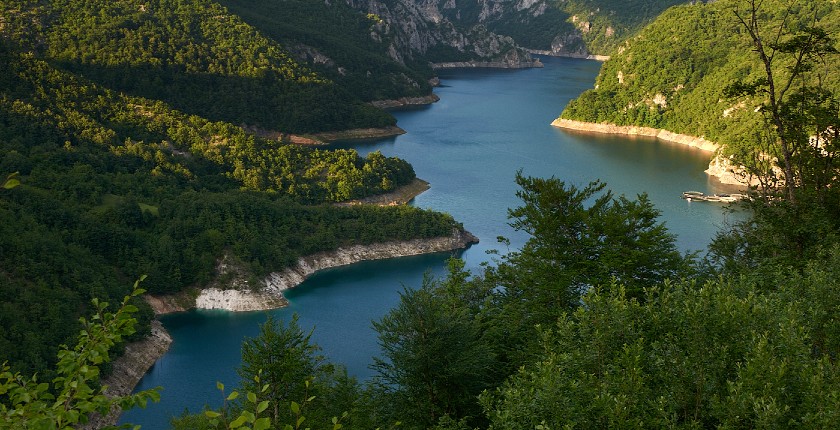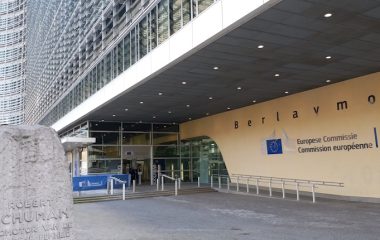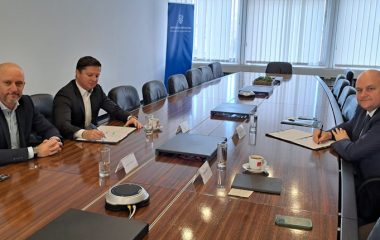
Photo: Dusko Miljanic
Published
August 30, 2022
Country
Author
Share
Published:
August 30, 2022
Country:
Author
Share
Depending on the assumptions on the trend of global emissions and the impacts of climate change over the next three decades, there is significant fluctuation in the expected water flows in the Drina River basin, so hydroelectric plant productivity cannot be projected with confidence, according to a Nexus Assessment report published by GWP-Med and UNECE. Investments in hydropower and dams are planned for a long-term period, so it is necessary to investigate potential risks to avoid lock-in into potentially unprofitable electricity supply mixes, which is equally true in the case of new thermal plants.
The Drina river and its tributaries flow through Montenegro, Bosnia and Herzegovina and Serbia. The construction of several hydropower plants in the basin was one of the drivers of economic development in the second half of the 20th century.
Now climate change seems to be taking its toll. Water levels have been setting record lows in the summer season over the past several years. The situation is alarming throughout Southeastern Europe and much of the continent.
Data from an analysis published in the Phase II Nexus Assessment for the Drina River Basin indicate rising risks for investments in new hydropower capacities.
The operation of hydropower dams affects overall water use and related ecosystems, so comprehensive regulation is needed to avoid intersectoral friction and cross-border issues
The operation of the cascade of dams for hydropower generation was identified as one of the most prone to causing intersectoral friction and cross-border disputes. The activity affects other water uses, the watercourse and water-dependent ecosystems. Experts that prepared the document also highlighted inconsistencies in the governance and management of natural resources in the Drina basin and gaps in regulation on a regional level and provide recommendations on how to resolve them.
The Assessment was issued within the framework of the project “Promoting the Sustainable Management of Natural Resources in Southeastern Europe, through the use of the Nexus approach”. It was financed by the Austrian Development Agency (ADA), and implemented by Global Water Partnership – Mediterranean (GWP-Med) in partnership with the United Nations Economic Commission for Europe (UNECE).
Room for synergies, dialogue on trade-offs
The Water-Energy-Food-Ecosystems Nexus approach is about the coordination of these sectors and the integration of their policy objectives, moving beyond traditional isolated sectoral thinking. In the case of conflicting sectoral interests on the use of a scarce resource (such as water), there are ways for stakeholders from all sides to find mutually acceptable solutions, but the matter must be resolved from a single, integrated perspective. It requires taking into account the interests and priorities of all sectors as well as stakeholders: the local population, investors, municipal and state authorities with their strategic objectives and so on.
For some projects or demands, for instance to use river water for irrigation in an area, mutually beneficial solutions or synergies can be found. In other cases, the costs and benefits need to be prudently weighed so that neither side is at a greater loss in the trade-off.
If power system developments follow the business-as-usual scenario, there is a risk of remaining stuck with the existing technologies
Be as it may, water is the most fundamental natural resource and its current scarcity has the most immediate impact on all economic sectors, the environment, people, countries and bilateral and regional relations.
The Nexus Assessment focuses on two main aspects with regard to sustainable development and transboundary cooperation. The first is the development of the electricity sector in the basin and the riparian countries overall, primarily renewable energy and hydropower. The other challenge is to reach formal agreements on key aspects of flow regulation, considering all water uses.
The experts agreed that the said negative effects can be avoided or reduced by effectively addressing potential water-energy Nexus issues early on. “This in turn requires empowering water managers and environment authorities to open and maintain an informed dialogue with the energy sector, including utilities. Such dialogue, especially to the extent it looks into mid- and long-term infrastructure investments, can benefit from a model-based scenario analysis,” the document mentions.
Modelling analysis, based on range of scenarios, can help infrastructure investment talks
The Assessment, analysed several scenarios , each representing potential alternative ways the water-energy system could evolve in the Drina river basin in the next two decades.
The business-as-usual scenario works as a reference, where limited action occurs, and it assumes no noticeable climate change. It takes into account currently established policies and committed investments in power supply infrastructure. Since the plans for hydropower development in the Drina basin are not fully confirmed, they were excluded.
The hydropower plant development or HPPDev scenario investigates how both hydro and non-hydro renewable generation in the basin would evolve with new hydropower infrastructure. It assumes that three new hydropower plants are to be built: Buk Bijela, Foča, and Paunci in BiH. In both scenarios, renewable energy expansion is limited and old thermal plants are mainly replaced by new ones.
The ambitious scenario investigates the impact of energy efficiency measures and further technological advancements in non-hydro renewable energy
With HPPDev as its basis, the renewables scenario investigates the effect of decreasing investment costs in non-hydro renewables on the fuel mix and the emissions of the power system.
The climate change scenario evaluates the impact of climate change on hydropower generation and the entire electricity mix. Another scenario introduces an emission trading scheme or ETS.
Finally, the ambitious scenario investigates the impact of energy efficiency measures and further technological advancements in non-hydro renewable energy on generation investments and profiles in and outside of the basin. It applies an annual 0.8% reduction of the electricity demand in each of the riparians, in line with the European Union’s Energy Efficiency Directive.
Ambitious climate policies would pulverize thermal power plant share
In other findings from the modelling analysis:
- The role of hydro and non-hydro renewables is paramount in decreasing emissions, where their cost is reduced, or policies become more favorable. Total CO2 emissions show a considerable decrease in the renewables and ETS scenarios and especially in the ambitious one.
- Non-hydro renewables can be competitive with coal power plants but not with hydro generation. The increased share of non-hydro renewables in the renewables, ETS and ambitious versions doesn’t significantly influence the share of hydropower. It affects coal plants instead, significantly reducing the need for them and making the electricity supply mix overall greener.
- The establishment of an emission trading scheme would have significant effects on the least-cost electricity supply mix. The power output of existing thermal power plants would drop by 80% in 2028 from the 2020 level.
- The technical feasibility of a system with high shares of non-hydro renewable energy is possible and should be studied in detail, jointly with the necessary regional integration of transmission infrastructure.
Comprehensive approach acknowledges roles of wastewater, solid waste management, erosion prevention
In parallel to the above integrated energy-water modelling analysis, the Phase II Drina Nexus Assessment also includes a study on key aspects of flow regulation in the basin. It was based in part on interviews with representatives of key institutions for their perspectives and up-to-date policy developments and management practices. It was developed in consultation with the Drina Expert Group on Flow Regulation and Environmental Flows, building up on UNECE’s Desk Study on Environmental Flows and Flow Regulation in the Drina River Basin from 2020.
Experts recommended several steps for flow regulation at the national level in all Drina countries
Experts recommended several steps for coordinating flow regulation at the national level in all Drina countries. These include integration with national disaster risk reduction planning – Sendai Framework, improvement in the integration in planning, with an intersectoral exchange of information, and an expanded scope of transboundary strategic environmental assessments (SEAs) on a pilot basis.
The study also points to good practices in transboundary water allocation taking into account approaches to environmental and minimum flow as well as clauses for hydrological extremes, and lays out some possible directions to help the Drina riparian countries in their cooperation.
The authors called for an acceleration in sustainable infrastructure investments and the improvement in the management of wastewater and solid waste.
The report suggests that erosion- and sedimentation-related pressures on water quality need to be addressed. Namely, deforestation and human intervention add to erosion, which decreases agricultural land and contributes to sedimentation in reservoirs at dams, reducing their available capacity.
Looking forward: Towards enhanced transboundary and cross-sectoral cooperation in the Drina basin
In order to move towards sustainable and climate-resilient management of natural resources in the Drina basin, it is therefore essential that integrated and coherent policy-making is ensured across the water – energy – land/agriculture – environment sectors at both the national and transboundary levels.
Representatives of the related Ministries from the Drina riparian countries discussed and approved a “Nexus Roadmap” that was prepared in that regard in the framework of the SEE Nexus Project.
The Roadmap, building up on the experience and findings of recent key projects in the basin, identifies 10 policy objectives and suggests main lines of action in order to achieve them.
The first four objectives are of general nature and focus on priorities and modalities to strengthen cooperation, governance, policy instruments as well as infrastructure investments. The other six objectives pertain to specific Nexus issues identified during the Nexus Assessment process and include suggested actions to improve data and info exchange, to co-optimise the regulation of water flows, to improve management of wastewater and solid waste, to reduce erosion- and sedimentation-related pressures, to foster sustainable renewable energy development and to promote agricultural, rural, and eco-tourism development.
The publications are available to download at the links below:


















Be the first one to comment on this article.